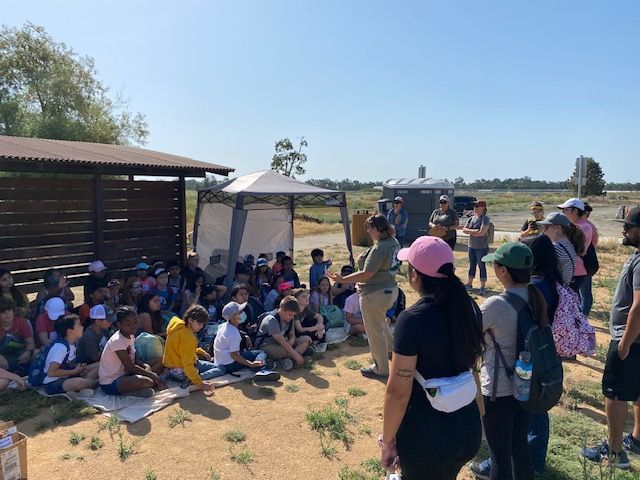Last Field Trips of the School Year at Woodland Regional Park Preserve

With the end of the school year, Tuleyome’s field trips to Woodland Regional Park Preserve (WRPP) have concluded until next fall. The inhabitants of WRPP did not disappoint – they were on full display for the kiddos, showing off their home and delighting the students every step of the way.
At the Red-Tailed Hawk’s nest, we can now spot 2 baby hawks perching on the edge of their nest. Their darker feathers are starting to come in and they are growing rapidly, looking like they are anxious to take their first flight. Mom and Dad soared high above, keeping a watchful eye on things but staying in view of their babies and our binoculars. The Killdeer roamed the pathway as we walked along, which thrilled the students, and we even spotted a new addition to the Preserve- Magpies with their beautifully patterned black and white wings. Tiny frogs jumped about and turtles, large and small, lined logs in the pond. But, one of the most exciting moments for the students was when a family of geese, 4 goslings in-line with their parents, crossed the path directly in front of us. It was as if something out of one of their storybooks had come alive just for them.
After our walk through the Preserve, we headed back to the Kiosk area for a snack and short break before beginning the nature craft. The craft chosen for this group was the Seed Creatures craft- a “seed bomb” mixture of clay, organic soil, and native wildflower seeds that students got to mold into their favorite creature from the Preserve. We had lots of turtles, birds, leaves, and even eggs. The seed creatures dried in the sun for a bit while students enjoyed a few more moments at the Preserve. Then, they took their seed creatures with them as they prepared to leave, along with instructions on how to plant them. In the Fall, when they plant their Seed Creatures in a pot, home or school garden, they will be able to remember their time at the Preserve and why we work to protect these special places.
The last field trip was the first to participate in one of our SEL (social-emotional learning) trails which includes a nature walk and nature craft. This highly engaged, highly energetic group of kids were enthusiastic nature-lovers already and they were more than eager to adventure in the Preserve. In fact, they hiked the farthest along the trail than any other group their age!
The focus of the SEL nature walk is to engage students in a discussion about the need for preservation and conservation of special places like our urban regional park preserve, and to share with them all the beauty and wonder they can find there.
-Kara Green
RECENT ARTICLES






